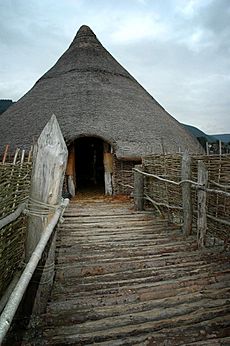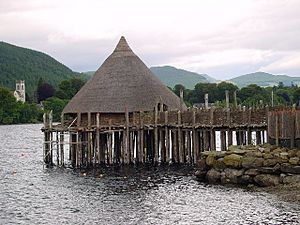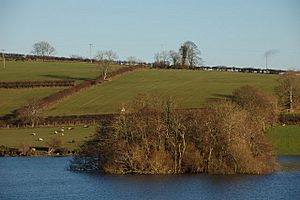Crannog facts for kids
A crannog (in Irish: Irish: crannóg; in Scottish Gaelic: Scottish Gaelic: crannag) is a special type of artificial island. These islands were usually built in lakes and river mouths in Scotland, Wales, and Ireland. Unlike some ancient homes built on lake shores, crannogs were made right in the water. This made them unique island homes.
People lived on crannogs for a very long time, over 5,000 years! They were used from the Stone Age all the way up to the 17th and early 18th centuries. In Scotland, the earliest crannogs we know about date back to the Late Bronze Age or early Iron Age. This means they were built around 800 BC or even earlier.
Crannogs could be built in different ways. Some were wooden structures, while others were mounds of brush, stone, or timber. These mounds were often held in place by wooden poles. In places like the Outer Hebrides in Scotland, where wood was scarce, crannogs were built entirely from stone. Today, crannogs often look like small, round islands, about 10 to 30 meters (30 to 100 feet) wide. They are usually covered in thick plants because animals can't easily reach them to graze.
Contents
Where Are Crannogs Found?
Crannogs are very common in Ireland, with about 1,200 known sites. Scotland has around 350 to 500 sites. The exact number in Scotland can change because some similar island homes are called "island duns" instead of crannogs. Even today, new crannogs are still being discovered as people explore the bottoms of lakes.
In Ireland, most crannogs are found in the central, northern, and northwestern parts of the country. In Scotland, they are mostly on the western coast, especially in Argyll and Dumfries and Galloway. The Western Isles actually have the most lake settlements in Scotland, even if they aren't all called "crannogs." There's only one known crannog in Wales, at Llangorse Lake. It was likely built due to Irish influence.
You can visit reconstructed crannogs today! There's one at Craggaunowen in County Clare, Ireland, and another at the Irish National Heritage Park in Wexford, Ireland. In Scotland, the "Scottish Crannog Centre" on Loch Tay in Perthshire offers tours and activities. You can try things like wool-spinning, wood-turning, and even making fire! They also hold special events and celebrate ancient festivals like Midsummer, Lughnasadh, and Samhain.
What Were Crannogs Used For?

Crannogs were built in many different ways, depending on the materials available. Early ideas about crannogs often came from old drawings and excavations, like the one at Milton Loch in Scotland. This showed a small island with timber piles around its edges, connected by a walkway, and topped with a typical Iron Age roundhouse.
Living on a small island might seem strange now. But in the past, waterways were the main way to travel and communicate in much of Ireland and Highland Scotland. Crannogs were often seen as simple farmhouses. However, they also had other uses:
- Safe Havens: They could be places to hide during times of danger.
- Status Symbols: Their limited access made them symbols of power and importance for wealthy families.
- Family Homes: They were often passed down through generations, showing a family's long history and claim to the land.
The definition of a "crannog" has been debated for a long time. A strict definition says a crannog must use timber in its construction. This means some stone-built island homes in the Western Isles aren't always called "true" crannogs, even though people lived on them in similar ways. These stone islands are sometimes called "island duns" or "Atlantic roundhouses."
Many early crannog excavations (digs) were not done as carefully as they are today. In the late 1800s and early 1900s, workers sometimes removed tons of material without properly recording what they found. This makes it hard for modern archaeologists to learn much from these old digs. Also, techniques to preserve waterlogged materials like wooden boats were not good, so many important finds were lost.
Since the 1980s, more careful excavations have been done. These digs show that most crannogs were used many times over centuries. This suggests that people saw crannogs as important places, perhaps remembering their ancestors who lived there. This long history of use has been confirmed by radiocarbon dating and dendrochronology (tree-ring dating).
Over time, how people viewed crannogs changed. In prehistoric times, they might have been family homes. But in the medieval period, crannogs became strongholds for important people like kings and chieftains. This continued into the 17th and 18th centuries in Scotland.
History of Crannogs
The oldest known crannog is Eilean Dòmhnuill on North Uist in Scotland. It's a completely artificial island from the Stone Age, dating back to about 3650 to 2500 BC. In Ireland, crannogs appeared later, in the middle Bronze Age (around 1200–600 BC). Recent dating of wood found on the Isle of Lewis shows crannogs there might be as old as 3380-3630 BC.
Crannog building and use were most popular in Scotland from about 800 BC to AD 200. Crannogs offered good defense, but they seem to have been more than just forts. Very few weapons or signs of battles are found in prehistoric crannogs. In Ireland, crannogs were most popular during the Early Historic period. They were homes and safe places for kings, lords, wealthy farmers, and sometimes even people who wanted to live alone, like monks or metalworkers.
How Crannogs Were Built
The way crannogs were built varied a lot. They could range from small, natural islands that were later used, to completely artificial islands built from scratch. For true crannogs, construction usually started on a shallow reef or a raised area at the bottom of a lake.
If wood was available, many crannogs were surrounded by a circle of wooden poles. These poles had sharpened bases and were driven into the lakebed. This circular fence helped to hold the main mound in place and stop it from washing away. The poles could also be joined together with special interlocking joints to make the structure stronger. Inside this circle, builders would pile up clay, peat, stone, timber, or brush – whatever materials they could find nearby. Sometimes, more than one building was constructed on a single crannog.
Other crannogs were built by adding large stones to the waterline of small natural islands. This made the islands bigger over time. Larger crannogs could be home to big families or even whole communities. People usually reached them by small boats or coracles (lightweight boats). Many crannogs also had wooden or stone walkways connecting them to the shore. These walkways might have been slightly underwater, possibly to make it harder for enemies to reach the island.
Because crannog sites are often waterlogged, many ancient objects are found in excellent condition. Bones from cattle, deer, and pigs have been found, along with wooden tools and even ancient dairy products, preserved for thousands of years!
Images for kids
-
A replica crannóg on Loch Tay
See also
 In Spanish: Crannog para niños
In Spanish: Crannog para niños




